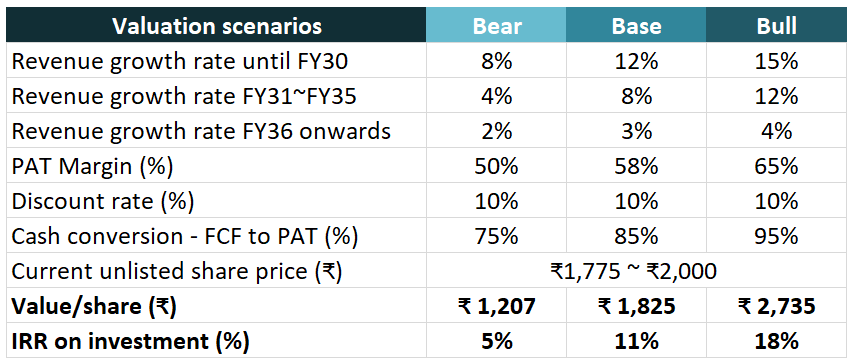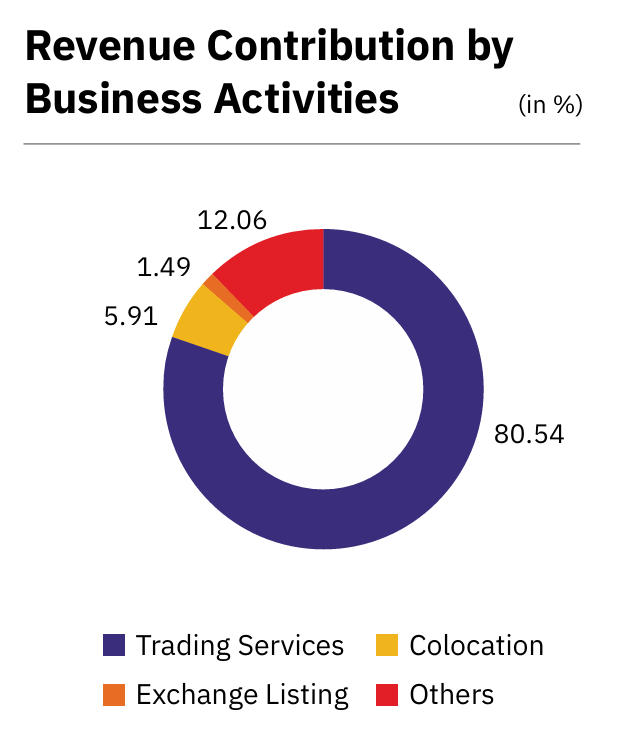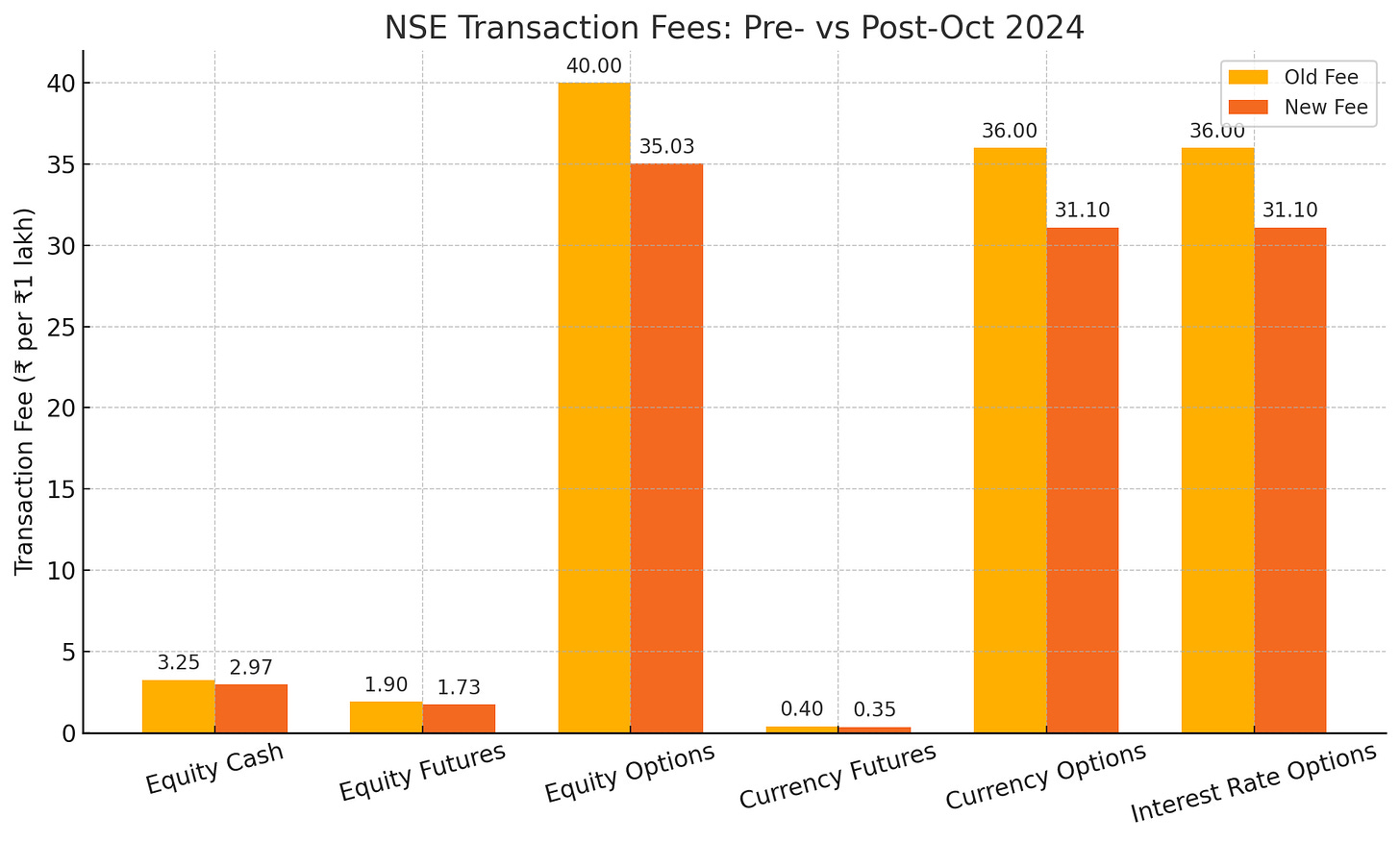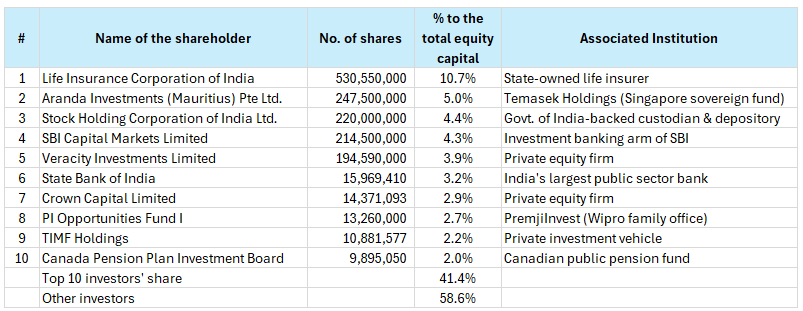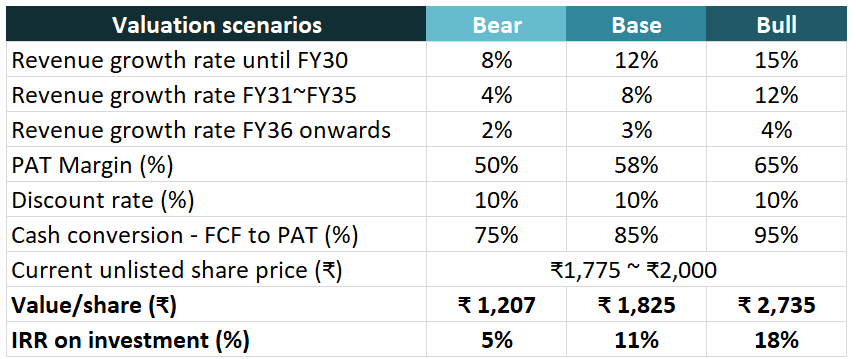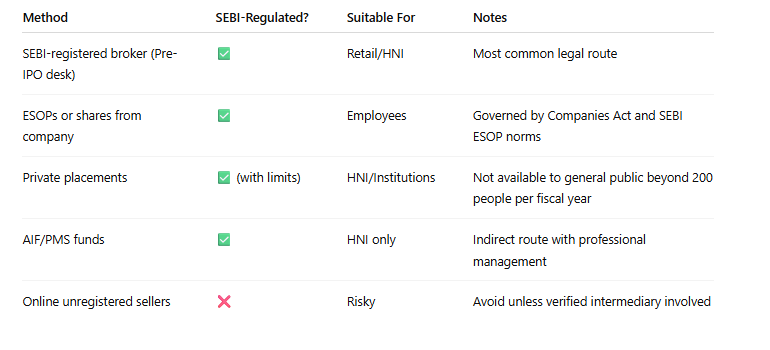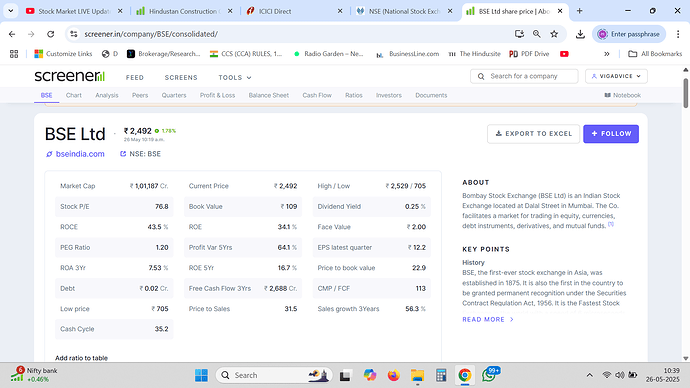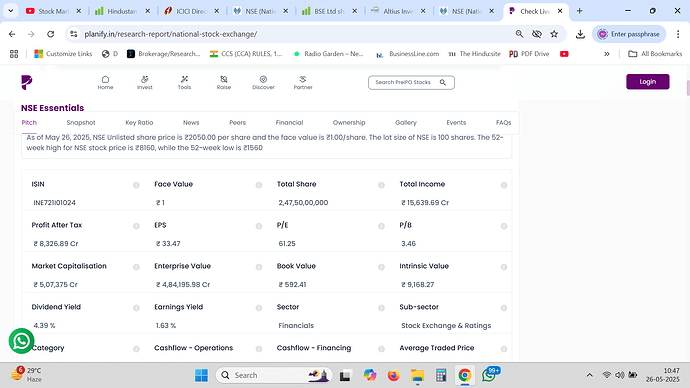Hi all,
Starting a thread on NSE , as it is potentially going to IPO in the next 1~2 years. I recently valued their unlisted shares - please go through and let me know your feedback:
Summary
The National Stock Exchange of India (NSE) is essentially the house in India’s financial casino. With a near-monopoly on exchange volumes, eye-watering profit margins and a network effect that keeps competitors at bay, NSE offers long-term investors a chance to own a slice of the market’s infrastructure itself. It’s no surprise that NSE is valued on the unlisted market at approximately ₹~4.9tn ($~60bn). If the proposed IPO goes through, that would make it the 11th largest publicly listed company in India and 8th largest exchange operator globally.
From a valuation perspective, it seems fairly valued at the moment based on my assumptions below, but provides investors with a chance to buy a “wonderful business at a fair price”
Detailed analysis follows, covering:
- Industry overview
- Business model
- Management
- Financials
- Competitive advantages / moat
- Runway / future growth potential
- Risks
- Valuation & potential IPO
- Sources
Industry overview
India’s capital markets have been on a tear. Retail investor participation has exploded - the number of demat accounts quadrupled from 39 million in 2019 to 185 million by end-2024, with 46 million new accounts added in 2024 alone!
Domestically, NSE absolutely dominates, capturing about 93% of cash equity, 97% of equity options, and nearly 100% of equity futures market share. It also gets the lions share of new listings, with 268 NSE IPOs in 2024 (vs. 180 in 2023).
NSE and BSE, the largest exchanges in India, have been the fastest growing exchanges globally amongst the large economies (US, Europe, China and Japan).
Technologically, India’s market infrastructure is world-class. NSE pioneered electronic trading in the 1990s, leaving behind old open-outcry systems, and continues to push the envelope. Notably, India moved to T+1 settlement (trade plus one day) in 2023 (a feat few large markets have achieved), and is even experimenting with same-day T+0 settlements.
Business model
NSE’s business model is pretty straight-forward. It mainly earns revenue through trading fees, co-location and data services.
- Trading & Clearing Fees: Every time someone buys or sells a stock, bond, or derivative on NSE, the exchange earns a transaction fee. It charges almost 10x the fees for options vs. plain-vanilla equity trades (₹35 vs. ₹3.25 per ₹1 lakh of volume). It also passes on the benefits of scale to customers by reducing the fee per transaction as trading volume have been scaling up, as seen in the chart below.
- Colocation services: NSE offers colocation services where high-frequency traders can place their servers in NSE’s data center for ultra-low latency access to the trading engine. This was also where a scam took place in 2010 - more on this later.
- Listing fees: Companies pay NSE listing fees to have their stocks or debt listed and traded on the exchange.
- Other services: Data & information services, Real-time price feeds, historical data, indices, and analytics.
Apart from this, they also own 24% in NSDL and 15% in NCDEX and various other smaller entities related to the Indian capital markets.
Management
The current MD & CEO Ashishkumar Chauhan took over in 2022. He is an industry veteran with impeccable credentials: an IIT Bombay engineer and IIM Calcutta MBA, and was a founding member of NSE back in the 1990s.
However, NSE has had a chequered history, marked by multiple controversies, including the co-location scam, “Yogi” email scandal and multiple trading outages between 2010 and 2017.
Since then, there has been a “complete overhaul of its board, management and operational structures”. This seems to have paid off, as relations between NSE and SEBI have improved since Chauhan took over in 2022.
Ownership
NSE has a widely dispersed shareholding base with over 100,000 investors. Its equity is held by a who’s-who of top Indian and global financial institutions.
As per SEBI Regulations, NSE is required to ensure that at least 51% of the equity share capital is held by public i.e. not more than 49% to be held by Trading Member/Clearing Member/their associates. Currently, 56% is held under the “public” category.
Unlike a typical public company, the board and management team are selected in accordance to a SEBI policies and oversight. So, capital market functioning and investor protection would take precedence over NSE shareholder interests.
Monsoon Pabrai, one of the investors I follow, recently presented her thesis on NSE at the May 2025 ValueX conference. She also subsequently launched a Special Purpose Vehicle (SPV) to invest in the unlisted NSE, a fund targeted specifically at foreign investors.
Financials
NSE is a cash-generating machine with high margins, high returns on equity and a rock-solid balance sheet. In FY25, revenue grew 17% YoY reaching ₹192bn, with PAT margins at 64% and ROCE at 54%.
The high margins should continue into the future, due to NSE’s Operating leverage. Once the exchange’s fixed costs (technology, infrastructure, regulatory fees) are covered, each additional trade is mostly pure profit.
Capital allocation and dividend
- NSE has been shareholder-friendly with capital returns, with a dividend payout ratio of around 47% over the last 3 years.
- Re-investment rate has stayed around 5~7%, mainly to upgrade the trading infrastructure and introduce new products / safety protocols.
- The remaining 45% of profits are retained on the balance sheet, and mostly held in cash and fixed income instruments.
Competitive advantages / moat
- Regulatory and brand trust : NSE has gained the trust of regulators, institutions and retail investors over its 33 year operating history. SEBI is unlikely to license a new general-purpose stock exchange to compete head-on with NSE/BSE.
- Technology & infrastructure leadership: NSE’s scale and technological superiority over BSE has made it the platform of choice for high-frequency and algorithmic traders. However, BSE has managed to stage a mini comeback, increasing its options market share from 8% to 20% in the last year, primarily by offering lower transaction fees.
- Network effects & scale : NSE controls over 90% of Indian equity market volumes. It also offers a “one-stop-shop” for equities, derivatives, currencies, commodities, ETFs and fixed income. The NIFTY 50 and NIFTY 500 indices offered by NSE are the most popular and effective options for passive investment in Indian equities.
These 3 give NSE probably on of the best “moats” of any private or publicly traded business in India (or globally, for that matter). It is unlikely that their competitive advantage will be meaningfully challenged in the coming decades.
Runway / future growth potential
NSE is already a mega-cap. However, it still has a lot of tailwinds and I expect it to remain a “growth” company for the next few decades.
- Growth in the Indian market capitalization: India’s total market cap is around $5T. There is a decent likelihood of the Indian markets doubling in the next 10~15 years. Several factors support this hypothesis:
- The Indian market was $2.7T in 2020 , so it has already doubled in size to $5T in the last 5 years.
- Approximately 45% of India’s GDP is still in the informal / un-organized sector, compared to 12%~25% in US and China
- Shanghai & Shenzen markets are close to $12T in market cap; Including Hong Kong and Taiwan , that figure goes up to $19T, almost 4 times the size of the Indian market
- Growth in equity participation : Only ~5% of Indians participate in equity markets, compared to 50%+ participation in the US and other developed economies
- Global market participation : NSE has established an international exchange in GIFT City (Gujarat International Finance Tec-City) to cater to offshore investors in a dollar-denominated environment. As the Indian market grows in size, it should continue to attract increasing foreign investment.
Investing in NSE at this stage can be compared to investing in the Nasdaq or HKEX a couple of decades ago; Given structural tailwinds, I expect the Indian equity markets to grow 1.5~2 times the pace of India’s overall GDP.
Risks
- Regulatory Risk: This is the biggest risk according to me; Being a regulated entity, NSE’s fortunes are intertwined with the regulator (SEBI) and government policies. Any future management lapses or fraud could lead to BSE or other exchanges gaining ground. Also SEBI has been on a multi-year crusade to curb speculative derivative trading. I see this as a step in the right direction, as 90%+ of retail investors lose money on F&O, derivatives and algorithmic trading.
- Competition: BSE, MCX, and other exchanges could carve out profitable niches or engage in price competition, potentially putting pressure on NSE’s margins and market share
- Market Cyclicality : A multi-year bear market could dampen trading volumes. However, I see this more as an opportunity to purchase NSE shares at lower valuations that a threat to the long-term investment thesis
- Technology and Cybersecurity Risk: Large scale or repeated lapses could lead to a SEBI crack-down or even jeopardize NSE’s license
Unfortunately, NSE is not a idiot-proof business by Buffett’s definition. However, as long as a competent management team remains in place, these risks do not appear to be existential.
Valuation
Globally, U.S. exchanges such as CME and Nasdaq trade at 20–30× earnings, making NSE’s 36× multiple on peak profits look elevated. However, given its strong growth trajectory and long runway, the valuation seems reasonable. Barring an extreme and extended market down-turn scenario, the unlisted shares appear fairly priced.
Details and calculations can be found in the sheet below.
20250524_Nse_Valuation_Opensourceinvestor.xlsx (28.3 KB)
IPO & potential listing
The NSE discussion in the mainstream media centres around the potential IPO, which has been delayed multiple times since 2016. That could potentially close the valuation gap above, but I don’t see it as a make-or-break event for a long-term investor. As long as the core business remains in-tact , I could care less if the IPO happens in 2025, 2035 or never happens at all. I am happy to remain invested for the next 20+ years (and hopefully forever).
Purchasing unlisted shares
The process for purchasing unlisted companies currently is far from straightforward. The only way seems to be via a SEBI-registered brokers or intermediary, which a large portion of Retail investors don’t have access to. SEBI also issuing a warning to investors in Dec 2024 to avoid “unregulated platforms that facilitate trade in unlisted securities”.
The unlisted market also isn’t great for price discovery , with a broad range of prices online currently, between ₹1775 and ₹2050.
Conclusion
Chris Hohn, widely regarded as one of the greatest investors of all time, views stock exchanges as outstanding investments due to their natural monopoly characteristics and powerful network effects. He recently explained his rationale for having invested in Deutsche Börse and the London Stock Exchange (LSE) in the past.
NSE appears to embody the very traits that Chris Hohn looks for—essential infrastructure, a near-monopolistic market position, and strong growth momentum. Yet, the irony is hard to miss: despite its mission to democratize capital markets, NSE’s own shares remain largely inaccessible to retail investors due to the opaque and cumbersome nature of unlisted share transactions.
I will re-visit this analysis once the IPO listing is finalized and the DRHP is released. In the meantime, thanks for reading and let me know what you think!

